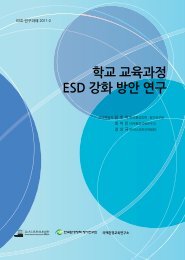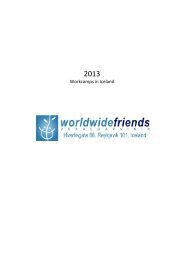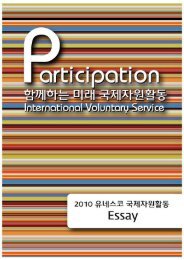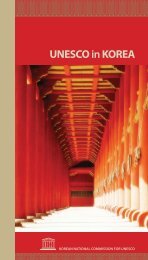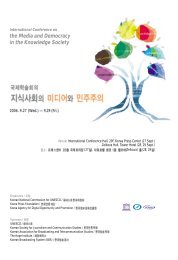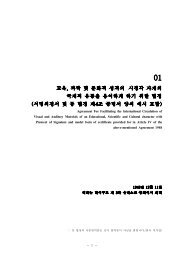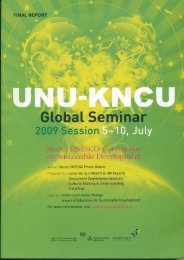DMZ ì¼ì ìí ííì ê´ë¦¬ë¥¼ ìí êµì 컨í¼ë°ì¤ - ì ë¤ì¤ì½íêµììí
DMZ ì¼ì ìí ííì ê´ë¦¬ë¥¼ ìí êµì 컨í¼ë°ì¤ - ì ë¤ì¤ì½íêµììí
DMZ ì¼ì ìí ííì ê´ë¦¬ë¥¼ ìí êµì 컨í¼ë°ì¤ - ì ë¤ì¤ì½íêµììí
You also want an ePaper? Increase the reach of your titles
YUMPU automatically turns print PDFs into web optimized ePapers that Google loves.
<strong>DMZ</strong> 일원 생태ㆍ평화적 관리를 위한 국제컨퍼런스<br />
forms of political cooperation, experiences and lessons from conflict-affected countries and<br />
regions over the past two decades suggest that harnessing the peace building potential of<br />
natural resources and the environment often moves along a pathway of cooperation<br />
comprising four key steps. The first step along this pathway is dialogue over shared<br />
resources or common environmental threats, which can bring divergent groups together,<br />
break down stereotypes and humanise parties in dispute. The second step entails sharing<br />
technical information on a specific natural resource or environmental threat, which may<br />
allow parties to depoliticise the issue and agree on a set of core facts. The third step along<br />
the pathway involves conducting joint field assessments, to help overcome differences. This<br />
step often includes impartial third parties and independent experts by both sides to facilitate<br />
the process and validate findings. The outcomes of joint assessments help to develop a<br />
common understanding of the challenge and a shared vision towards sustainable use and/or<br />
methods for addressing the environmental threat. The final step along the pathway is the<br />
coordinated or joint management of shared natural resources or environmental threats.<br />
Moving along this path, parties achieve higher levels of environmental cooperation,<br />
commitment, confidence and trust building, and reconciliation.<br />
❖ Case studies<br />
Experiences from three conflict affected regions demonstrate the manner in which<br />
protected areas have been used, to varying degrees, to help parties move along the various<br />
steps of the pathway of cooperation. Specifically, using protected areas as a platform for<br />
cooperation has helped parties resolve boundary disputes, as well as encouraged technical<br />
cooperation and rural development in these conflict-affected zones.<br />
1. The Peru-Ecuador Peace Park<br />
The border between Peru and Ecuador, known as the Cordillera del Condor, was at the<br />
centre of a dispute between the two countries for over 150 years. The last major conflict<br />
between the two countries took place in 1942 and ended with the signing of the Rio de<br />
Janeiro Protocol. However, the Protocol failed to clearly define the new frontier between<br />
Peru and Ecuador, and resulted in continued uncertainty, renewed tensions and sporadic<br />
violence. Following a series of prolonged discussions, the Acta Presidencial de Brasiliawas<br />
signed in 1998, and called for Peru and Ecuador to establish adjacent zones of ecological<br />
protection on both sides of the border in the Cordillera del Condor. In 1999, Ecuador<br />
established the El Cóndor Park, while Peru created an Ecological Protection Zone and the<br />
Santiago-Comaina Reserved Zone. The treaty has led to subsequent bi-national initiatives to<br />
manage and conserve the parks such as the "Peace and Bi-national Conservation in the<br />
Cordillera del Cóndor, Ecuador-Peru" project.<br />
98 ❙ <strong>DMZ</strong> 일원의 생태⋅평화⋅지역발전



